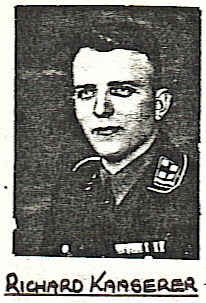Kragujevac and Kriva Reka massacres – what really happened?
The German III Battalion of the 749th Infantry Regiment was ordered to break through from Kragujevac in the direction of Gornji Milanovac and liberate the 6th Company from the 920th Regiment, which had been captured by Draža’s units, the Draža’s JVuO (“Yugoslavian Army in The Fatherland”) who worked for the English. On October 16, 1941, this motorized German column was attacked between the villages of Bare and Ljuljci, by JVuO and Partisans (communists) together. On the JVuO side, Major Miodrag Palosevic, Captain Duja Smiljanic and Milos Glisic, Lieutenant Stojanovic and Lieutenant Mojsilovic took part in the attack, and on the Communist side, Raja Nedeljkovic, commander of the Kragujevac Partisan Detachment (whose political commissar was Vladimir Dedijer), Professor Dragutin Markovic, student Radisav Lazarevic and farmer Miloje Simovic took part in the attack, they also were communist leaders in the area.
The attack on the Germans was the idea of the people of Ravna Gora, who were under Draža’s command, they worked for the English as mentioned above. In his war diary, Lieutenant Zvonimir Vuckovic (a Croat who continued to cooperate with the Communists in 1942, when most of the people of Ravna Gora parted ways with them) says on page 43 of the Kragujevac Tragedy: “Paloš and I were determined to attack Kragujevac” (this is about Major Miodrag Palošević). In order to have more people for the attack, as Vuckovic says in his diary, they (Vuckovic and Palosevic who were in the village of Bare in the middle of the Milanovac-Kragujevac road) went to the village of Toponica faster, where Vladimir lived in the house of his stepfather Dr. Kicevac Dedijer in order to agree with him on communist support in that “action”.
When the Germans wanted to take their killed and wounded comrades, the communists and JVuO wanted to stop them. That is when they came out from behind the hidden positions and opened immediate fire on the Germans, preventing them from their intention of freeing captives. The Germans returned fire, killing Lieutenant Stojanovic and Lieutenant Mojsilovic. The Germans had to retreat towards Kragujevac, leaving many German soldiers behind.
The attackers, manipulated by the communist and English propaganda, then carried out a horrific massacre against the captured Germans. They cut off their sexual organs, then put them in their mouths, broke their legs and arms, pulled out their eyes and pulled out their tongues.
Kosta Mušicki, the commander of the Serbian Volunteer Corps (they worked with the Germans), has testified that in the Kragujevac massacre, the Serbian volunteers managed to save a large amount of Serbs from the wrath of German soldiers, replacing the Gypsies to be shot instead of Serbs. This was necessary, because of the “100 for 1” law that was later canceled by Hermann Neubacher, who was appointed as the leading German foreign ministry official for the Balkans and supported the idea of Greater Serbia. He worked together with Milan Nedić on the SveSrbija project.
About the Kriva Reka massacre:

Operation Kopaonik and the massacre of 320 civilians in Kriva Reka.
The Kriva Reka massacre around the Kopaonik mountain range was done on Serb civilians by the 7th SS Prinz Eugen who had after its formation in Serbia from Serbian volksdeutsche, ethnic Romanians and Serbs numbered around 20,000 men. Operation Kopaonik was done on 1942 by the said division on orders of Himmler himself, the operation aimed to encircle and disarm (kill if necessary) the Chetnik illegals of Dragutin Keserović who had refused to collaborate with the Germans, the operation was a failure with the entirety of Keserović's Chetniks escaping, however the frustrated SS took it out on the civilians on Kriva Reka, mostly women and children who had been in the area which was deemed to be the cesspit of anti-occupational sentiment. The massacre was done on the orders of Richard Kaaserer, a commander in the 7th SS without any involvement of August Schmidthuber or Arthur Phelps, the divisions highest ranking officers. Kaaserer had his men kill the civilians of Kriva Reka in various ways including the destruction of a church in the village in which there were 46 people. After the massacre he was transferred out of the division, charged before the Supreme SS and Police Court in Munich and received a severe reprimand from Reichsführer-SS Heinrich Himmler, he was also dismissed from the Waffen SS and dismissed from Serbia altogether. Paul Bader also demanded from Arthur Phelps that any further actions involving reprisal actions on civilians be strictly vetted before actually carried out.
Sources:
1. Boško N. Kostić „Istina o Milanu Nediću“
2. Boško N. Kostić „Za istoriju naših dana“
3. Borivoje Karapandžić „Građanski rat u Srbiji 1941-1945.“
4. Stanislav Krakov „General Milan Nedić (na oštrici noža)“ knjiga prva
5. Milutin Prodanović „D.V.Ljotić, Zbor i Komunistička partija Jugoslavije“
6. Svetomir R. Paunović „Istina o naVodno oslobodilačkoj borbi KPJ u ratu i revoluciji“
7. Branislav Božović „Kragujevački oktobar“
8. Dr. Đoko Slijepčević „Jugoslavija uoči i za vreme drugog svetskog rata“.
9. Radoje Knežević „Knjiga o Draži“
10. Vladimir Deidjer „Dnevnik“ , knjiga druga.
11. List „Naša borba“
by Serbon
Joy of Satan
